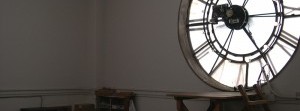
Photo Credit: Jane Stevenson
The Collections Renewal Project: Bringing the past to light
I’ve poked around in museum backrooms throughout BC’s Northwest; wearing those white gloves while sifting through old papers in archives and artifact storage rooms. I’ve peeked into acid-free envelopes, pulled down oversized file-folders, opened storage lids to lift layers of acid-free tissue paper and stood before oversized archival map drawers in total awe. Some of this unrestrained curiosity was during my past profession as an archivist, but there have also been countless enjoyable hours since then spent meandering through collections looking for that untold historical event that I could write about next.
Usually a museum’s artifact storage area is locked up behind closed doors and unavailable to the general public. Artifacts may be temporarily or permanently displayed in an exhibit, but the majority of a museum’s collection tends to be in storage. That’s why the Bulkley Valley Museum’s ongoing Collections Renewal Project caught my attention. This Smithers museum is reviewing its entire collection by carefully bringing artifacts out of storage and into its public gallery space for assessment and description.
Assessing and describing a museum’s collection in the public eye isn’t a usual museum practice but the BV Museum’s curator, Kira Westby, saw a need and came up with a creative solution. “The Collection Renewal Project helps us understand what we have and what condition the artifacts are in,” says Westby.
She guides me to the storage room where she and assistant Betty Campbell, with the help of keen summer students Eric Holdijk and Alicia Stahel, have been making progress. I can see right away the shelves they have tackled: similar artifacts are grouped together and sealed away in transparent bins or under dust covers. The remaining shelves look like a jumble of miscellaneous items.
“Our goal was and still is to do a complete inventory of the 3,000-plus artifacts that are in the museum’s collection,” says Westby from a cramped aisle. “We are individually examining each item, determining whether it is in need of stabilization or treatment, and what we can do to improve its current condition.” In order to have room to do this the staff have to move the artifacts, a few at a time, out of the crowded storage space to large tables in the public gallery.
Westby and the seasonal staff carry out the condition assessments at a table full of interesting and ever-rotating artifacts. Museum visitors passing through can see the variety of items currently being assessed. The museum’s main gallery has become a public workspace, with guests observing and interacting with the collection assessments.
A fascinating hodgepodge
On the day I happened to drop in there was a fascinating hodgepodge of items—trophies, stone tools, war memorabilia, bread wrappers, medicine bottles, 1950s board games and more—all working their way through the Collections Renewal Project. “The artifact is individually assessed, cleaned and photographed,” explains Westby. “The importance of documenting the collection is to make sure the objects are identified, their history documented and their information confirmed and updated in our records.”
“Having the Collections Renewal Project taking place in the main gallery space has given visitors a chance to engage and participate in the process,” Westby says. It’s often a two-way exchange with the visitors talking about their knowledge of the items on display and the museum making guests aware of the wide variety of local artifacts in its collection. This public engagement has often led to a deeper understanding of the more mysterious items; tourists have translated foreign languages on artifacts and assisted in the understanding of now-unfamiliar household items.
One of the mysterious objects that caught my eye was a complicated, jointed wooden contraption that turned out to be a buggy jack. How many people alive today know what a buggy jack looks like? And just imagine (as I did) what changing a wooden wagon wheel on the Telkwa High Road with a season’s supply of flour, sugar and beans on board would be like. I mean, really, did one carry a buggy jack and spare wagon wheels? I was fascinated. This is what museums should do—make the mind wonder.
The public discourse is taking place beyond the museum walls as well. “We’ve been reaching out to the community with weekly newspaper articles. We are now on Facebook and Twitter, and we worked with community radio CICK to do a show on our Collections Revival,” says Westby. The radio episode featured items from the museum’s collection, including a mysterious music box that dispensed cigarettes. A local listener helped identify the tune the music box played. “It’s community engagement like this that helps deepen our knowledge of the artifacts and also helps keep our museum connected to the public.”
On the museum’s To-Do list is a revitalization of its permanent exhibit space and the Collections Renewal Project is helping the museum staff plan for future displays. Westby explains: “Without knowing exactly what we have it is hard to make a solid plan for future exhibits.” As a significant bonus, especially for curious people like me, the improved knowledge of the collections will allow for better access to the collection for research purposes.
Preventative preservation
After the artifacts have gone through the gallery and their records have been updated they are returned to storage. Westby is mindful of the museum’s role in preventative preservation and wants to make sure they are meeting all the current standards of collections care. “Part of this project is combating the active deterioration of the collection,” she states. Back in the storage room I can see the dust covers, sealed bins and pest control that the museum has put in place to combat the agents of deterioration. I also see interesting objects everywhere; I could poke around in here for hours.
Westby and I chat about the collection and how every time she comes into the storeroom she sees an item that she didn’t notice previously. I remark at how interesting the objects are and she replies, “It’s not enough for the artifacts to be old and interesting; they have to have relevance to our museum mandate and our local history.” This underscores the importance of the ongoing project of confirming the accuracy of the existing records.
Over the years, in various museums across our Northwest, I’ve found treasures—photos of armoured war trains along the Skeena River, farmers’ journals noting locusts with their weather events, old maps with layers of pencil scratches showing watering locations for cattle drives, and more—so much more! These treasures are being uncovered and cared for by museum staff and volunteers.
Thank you to all those in charge of our collections, whether volunteering on a museum board or carrying out the day-to-day operations. Thank you for making sure all of our old and interesting stuff has a well-documented history. Anyone who is staring at a buggy jack years from now will thank you for writing that down.





